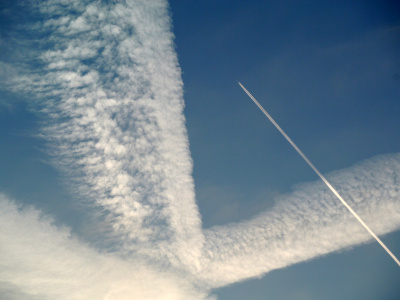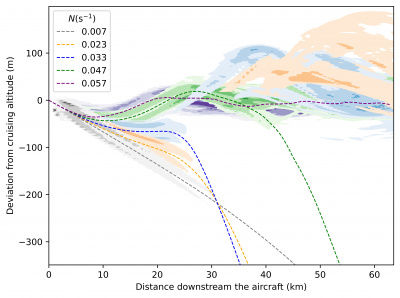Effects of atmospheric stratification and jet position on the properties of aircraft wake and early contrails
Pierre Saulgeot, Département aérodynamique, aéroélasticité, acoustique, ONERA - The French Aerospace Lab - Centre de Meudon
The net impact of aircraft contrails on global climate change is a matter of controversy today (Lee et al., 2021). Among the many parameters potentially influencing this issue, the role played by the aircraft wake has received only little attention so far. Yet the interaction between the jets causing these contrails and the aircraft wake leads to large modifications in the contrail’s altitude, ranging in hundreds of metres (Jacquin & Garnier, 1996). Figure 2 shows the different behaviors of the wake vortices and engine plumes of a B777 for several atmospheric stratification rates. Three cases are represented: the vortices descend while dragging the plume, the vortices descend but the plume remains at the flight altitude or the vortices do not descend and neither does the plume. This change in altitude heavily influences the net impact of contrails to global climate change, since the related change in temperature affects the ice content and the radiative properties of these contrails (Unterstrasser & Görsch, 2014; Unterstrasser, 2014; Unterstrasser et al., 2014). This vortex entrainment strongly depends on the relative positioning of the jet with respect to the tip vortices. Furthermore, after the formation of the tip vortices and the turbulent diffusion of the jet, the jet dispersion is also driven by buoyant forces associated with atmospheric stratification. Here we focus on the vortex entrainment and buoyancy effects by running a large number of two-dimensional simulations, scaled by the Brunt-Väisälä frequency and jet to tip vortex spacing, of the flow from the aftermath of the jet turbulent diffusion, vortex roll-up and initial ice formation up to the vortex destabilization stage. We use here the Boussinesq approximation, and we compare our results with full Navier-Stokes simulations. The very near wake dynamics are not simulated and instead replaced by an analytical description for the vortex, the jet and the ice plume. Ice water content is determined from the offset to ice saturation, given prescribed ambient conditions. The jet lateral spacing is considered in the range from fuselage to wing tip. The potential radiative impact of the early wake is calculated using the total extinction induced by the ice plume. The results are indicative of the impact of older contrail cirrus clouds, the largest proportion in the whole contrail radiative impact. The parametric mapping (stratification, jet spacing) highlights the important role played by the jet position on the opacity of early contrails, for regular stratification levels. In particular, a jet located closer to the wing tip results in contrails located at lower altitudes and reduced optical thickness, suggesting that jet positioning could be an interesting mean of contrail mitigation. Eventually the results also explain several real life observations. We also study some 2D instabilities of the wake that appear for some values of the Brunt-Väisälä frequency.

Figure 1: Photograph of contrails of various ages.

Figure 2: Ice mass (solid colors) and wake vortex trajectory (dotted lines) left by a Boeing B777 of average weight at RHi = 130% for several values of Brunt-Väisälä frequency.
References
Jacquin, L. & Garnier, F. 1996 On the dynamics of engine jets behind a transport aircraft.ONERA-Publications-TP .
Lee, D. S., Fahey, D. W., Skowron, A., Allen, M. R., Burkhardt, U., Chen, Q., Doherty, S. J., Freeman, S., Forster, P. M. & Fuglestvedt, J. 2021 The contribution of global aviation to anthropogenic climate forcing for 2000 to 2018. Atmospheric Environment 244.
Unterstrasser, S. 2014 Large-eddy simulation study of contrail microphysics and geometry during the vortex phase and consequences on contrail-to-cirrus transition. Journal of Geophysical Research: Atmospheres 119 (12), 7537–7555.
Unterstrasser, S. & Görsch, N. 2014 Aircraft-type dependency of contrail evolution. Journal of Geophysical Research: Atmospheres 119 (24), 14,015–14,027.
Unterstrasser, S., Paoli, R., Sölch, I., Kühnlein, C. & Gerz, T. 2014 Dimension of aircraft exhaust plumes at cruise conditions: effect of wake vortices. Atmospheric Chemistry and Physics 14 (5), 2713–2733.